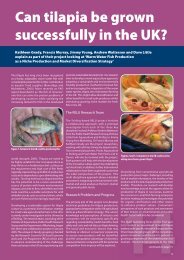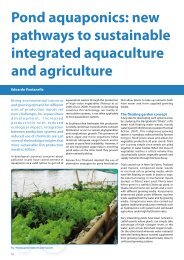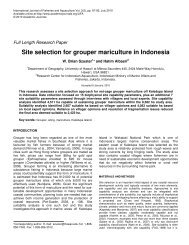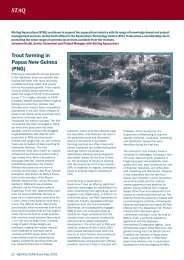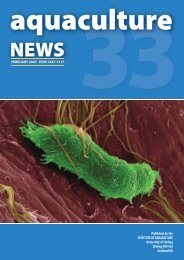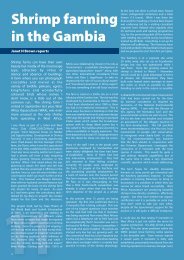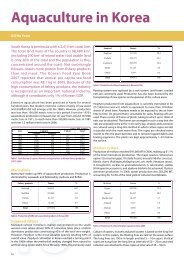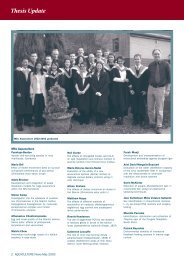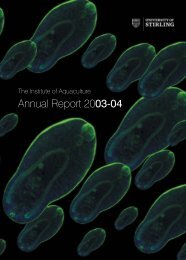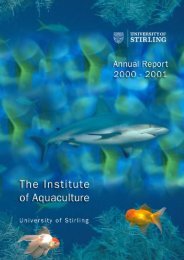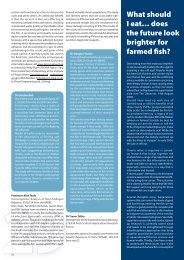Christopher Hepburn
Christopher Hepburn
Christopher Hepburn
You also want an ePaper? Increase the reach of your titles
YUMPU automatically turns print PDFs into web optimized ePapers that Google loves.
Pathways to fisheries restoration<br />
Community management, science and traditional ecological<br />
knowledge<br />
<strong>Christopher</strong> <strong>Hepburn</strong>, Stephen Wing,<br />
Henrik Moller and Nigel Scott
History of New Zealand’s fisheries
Rebuilding Global Fisheries. Boris Worm et al. (2009) SCIENCE<br />
VOL 325<br />
New Zealand’s<br />
Quota Management System<br />
25 years old<br />
Model system<br />
“Not overfished” (Worm et al. 2009)
Local stories of decline...<br />
…since the ’90s ... If you want pāua<br />
[abalone] you have to have a wet suit.<br />
...our people … are seeing those<br />
[commercial] boats just outside the<br />
waves taking their kai [food]….those<br />
trawlers just seem to wipe the whole<br />
inshore fishery out.<br />
…I cannot get my daughter, who’s 14, a<br />
fish off our traditional reef. It’s as<br />
simple as that.
Haliotis iris: New Zealand’s<br />
iconic gastropod fishery<br />
“Number one fisheries concern” of<br />
most people<br />
Paua is a taonga species of<br />
indigenous people<br />
Local population structure<br />
Pāua support a commercial fishery<br />
worth $50 million to the New Zealand<br />
economy<br />
Haliotis fisheries have collapsed in<br />
many regions
QMS Paua management–<br />
One size fits all approach<br />
125 mm<br />
10 per person per day<br />
Breath-hold diving only
We must capture variability in our<br />
management interventions
Treaty settlement<br />
10% of existing and 20% of new quota<br />
Customary fisheries tools<br />
Temporary closures<br />
Taiapure<br />
Mataitai
Addressing variability and change:<br />
Customary Management areas<br />
Coastal<br />
Marine<br />
Reserves<br />
375 km 2<br />
Customary<br />
Management<br />
Areas<br />
560 km 2<br />
•Legislation to allow local communities<br />
to manage fisheries at scales relevant<br />
to the stock<br />
•Opportunity for area management<br />
network<br />
•Major investment must be supported<br />
by the best management and science
Science to support ecosystem<br />
fisheries<br />
Productivity and structure of coastal<br />
ecosystems<br />
How coastal systems will respond to<br />
change<br />
How primary productivity relates to<br />
productivity of fisheries<br />
Engaging research in management<br />
tools to address variability, change<br />
and conflict within coastal fisheries<br />
Restoring fisheries with aquaculture
Supporting local management of<br />
fisheries<br />
WHAT ARE IMPORTANT TRAITS<br />
THAT INDICATE PRODUCTIVE PAUA<br />
FISHERIES?<br />
Baseline surveys (size,<br />
density, distribution,<br />
relationships with habitat and<br />
other species)<br />
Tagging programme (growth,<br />
movement, morphological,<br />
genetic information)<br />
Linking primary productivity to<br />
fishery productivity
Regional Variability: population structure
Case Study: East Otago Taiapure<br />
800 years of habitation and<br />
use<br />
First mooted in 1989 in<br />
response to concerns of<br />
elders of Kāti Huirapa ki<br />
Puketeraki for diminishing<br />
pāua stock<br />
Applied for in 1992<br />
Established in 1999 and<br />
committee formed in 2002<br />
First regulation in 2007 (set<br />
net restriction)
East Otago<br />
Taiapure
The Process<br />
Science supported local and<br />
customary knowledge<br />
Guiding management initiatives<br />
Providing information to the<br />
community (science evening,<br />
meeting, publication in local<br />
papers)<br />
Providing evidence to government
Outputs: Changing public policy<br />
Reduced bag limits<br />
•Paua (10 to 5)<br />
•Kina (50 to 10)<br />
•Tuaki/cockles (150-50)<br />
•Maximum combined shellfish 150-50<br />
•finfish 30 to 10<br />
Temporary Closure<br />
•2 year closure of Huriawa (Karitane<br />
Peninsula)<br />
to fishing for pāua<br />
No expansion of commercial tuaki fishing
Moving to fishery<br />
restoration<br />
Better fisheries management<br />
- Reef-by-reef management<br />
- Community-led management<br />
- Approaches using traditional<br />
ecological knowledge<br />
Reseeding stock from aquaculture<br />
to restore fisheries
Te Whaka a Te Wera<br />
Paterson Inlet<br />
Map Source: Ministry of Fisheries
Conclusions<br />
Quota management system has failed<br />
many inshore fisheries in New Zealand<br />
Customary tools may provide a pathway for<br />
better management and eventual<br />
restoration of local fisheries<br />
Communities need the scientific support<br />
and tools to make local management<br />
interventions work<br />
Successful fishery management cannot<br />
occur without protection of habitat
Acknowledgements<br />
Thanks to everyone who has helped out over the last few<br />
years especially, former and current students and staff at the<br />
Marine Science and Botany Departments, members of Te<br />
Tiaki Mahinga Kai, and the local communities around the<br />
East Otago Taiāpure, Te Punawai o Tōriki Mātaitai,<br />
Koukourārata Mātaitai, Whareponga and Waitutu.<br />
I appreciate the knowledge and support of my mentors<br />
Catriona Hurd, Brendan Flack, Maureen Wylie, Graeme<br />
Grennell and Tiny Metzger.<br />
Without the enthusiasm of University of Otago students my<br />
work would not be possible. Chris <strong>Hepburn</strong> is funded by a<br />
FRST TTP Fellowship (UOOX079)



